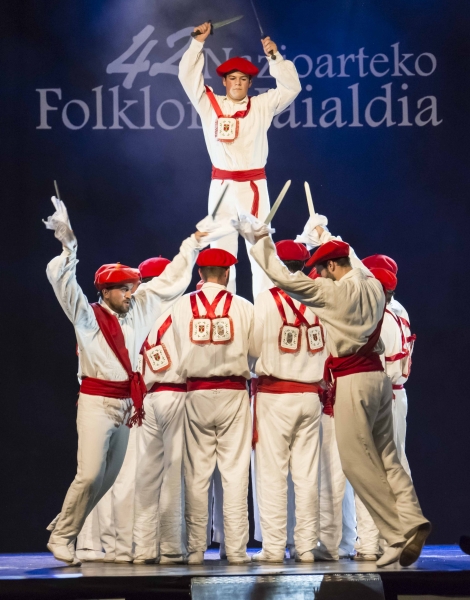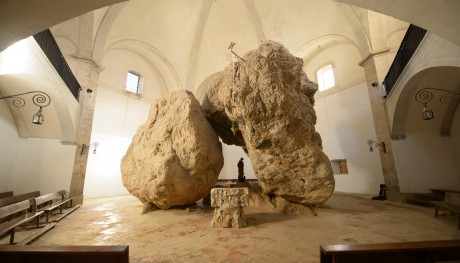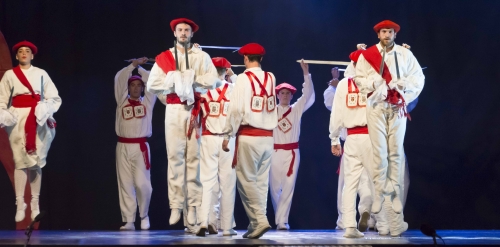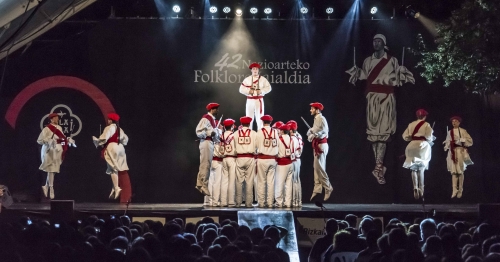XEMEINGO EZPATA-DANTZA
- Iñaki IRIGOIEN
- 15/ 10/ 2001
We link the localities of Xemein and Markina, which have been administratively merged for a long time, although historically they have held different exhibitions. Following this, the current way of performing the dance is described. Finally, historical references about this dance are listed, including the dances now forgotten.

This dance is performed on September 29 during the votive festivals in honour of the Saint in the old town hall of Xemein, alongside the chapel of San Miguel de Arrechinaga. In 1952 Xemein was merged with the village of Markina; they now have a single Town Council. When Xemein had its own town government the town hall was in Arretxinaga - next to the famous chapel - and festivals were celebrated in the square. This was explained in the 1802 in the 'Historical and Geographical Dictionary of the Basque Country': "alongside this chapel is the town hall of the republic, between them there is a small square where the village holds its bullfights and dances." The festival included sword dances, as it has since the villages were merged.
Both localities have always had the same parish church, Santa Maria de Xemein, yet despite this the most important festivals were always held separately, as were the dances performed during them. According to local records, in Markina they danced troqueados and in Xemein the sword dance which survives to this day.
The chapel which is found in Arretxinaga, devoted to San Miguel Arcangel, has an important peculiarity. In the interior you can find a megalithic monument of magnificent characteristics. Three quartz stones holding each other up occupy the centre of the chapel. They cover thirty metres of floor space a stretch eight metres high. A good deal of speculation has gone on as to their origin and placement. All of this has given a feeling to the sanctuary which leads us to believe that the Church erected the chapel on a site which was already sacred before the existence of Christianity.

After mass has been held in the chapel on the day of San Miguel Arcángel, the traditional Ezpata-dantza (sword dance) is performed in the aforementioned square. The dantzari (dancers), who have previously put on their traditional outfits in the old town hall, file out in formation without ritual to present the dance. First an arch of honour is formed by the group holding up long swords while directed by the captain. Traditionally, only authorities could pass through and now only the dancers of short swords can do so. Next they prepare themselves to perform the dance. First it goes in one direction and then it is done once again the same, after having formed the group facing the opposite direction.
This group is made up of an indefinite number of dancers, although currently the usual number is ten or twelve. They are divided into two files, joined by the swords held in their hands; the files end where the captain takes the swords of the first two members. They are all dressed in white with the exception of a red stripe on the sides of their trousers, with a "gerriko" or belt included which also acts as a sash across their chest, where you can also see scapularies with the figures of San Miguel and the coat of arms of the ancient town hall of Xemein. Next to the group there are an additional four dancers with short swords which are adorned with scarves on their hilts. Two of them dance alongside the first two members of the group while the other two do so next to the last two members. Their position is reversed when the group changes direction.
An important characteristic of this Ezpata-dantza is the elevation which is performed over the swords of the group. The swords have been previously placed in a stack in the form of a bonfire. Once lifted up, the captain or "Maisu zaharra" performs the dance with his hands, in which he holds two swords or daggers, while the dancers with short swords perform their dance on the ground.

Once the Ezpata-dantza is finished and a new arch of honour has been crossed under by the short-sword dancers, the group goes back to the old town hall. Immediately afterwards, they remove their swords and other objects and then form a chain of dancers which goes back out to the square to perform a solemn aurresku, when they lead the best-looking ladies out to the chain. The morning performance of the dancers ends with an offer of a refreshment for the ladies who have participated in the aurresku.
At night, the Zerutxu group represents old ceremonies in the middle of the square where the pilgrimage is being celebrated: the dinner which the authorities used to hold in the town hall and the important ritual near the chapel and the square which followed, ending with the dance of the "Maiganeko" on the banquet table.
First, a chain a men and women holding hands go round the chapel. They are led by a dancer with a lit torch in his hand who plays the role of the mayor. Next, another aurresku is danced, followed by a performance of the "Maiganeko" dance. The latter dance is led by the figure of the mayor at the head of the table; he offers wine to each of the dancers who, one by one, climb up and perform their dance on the table which has been placed in the middle of the square.
This is what can now be seen in Xemein. The tradition has survived mostly thanks to the efforts of the dancers of the Zerutxu group. The following will be some history about the dance and its background.
We will commence by pointing out that until the merger with Markina, the town hall was in the spot previously mentioned; the meetings of the Town Council of Xemein did not take place in Arrechinaga until Jan 1, 1646, so it was not the centre of the ancient town hall until that date. These meetings had previously been held in the chapel of San Jacinto de Ibarburu, where they met for the last time on December 31 of the previous year. They agreed on moving the following day to the chapel of San Miguel "which they designated and chose as the most convenient place for their meetings and for the town hall." The town council meetings took place here until 1741, when the town hall was built. At the same time the chapel was reconstructed and both buildings have remained the same since then.
This means that the first payments made to the txistularis, which can still be seen in municipal ledgers, were made for the festival of San Jacinto de Ibarburu. They were paid for entertaining with their "tambourines and flutes" and no mention was made of the sword dancers, so it is impossible to establish whether they existed at that time. It is important to add that one of the oldest mentions made in Vizcaya about the dancers, though not specifying if they were sword dancers, was made in the village of Markina in 1519. Upon receiving the news that Carlos V had been named emperor of Germany, it was decided that festivals would be held. Amongst them was a mention for "a tambourine to be taken through said village with some available men." In the ledgers we see that there were twenty of them, who went through the streets singing and dancing and bearing a flag.
In Xemein we also have the drummer or txistulari, who has always accompanied the dancers from the beginning. At times, especially at the beginning, there was only a drummer; at others, there was a kettle drum player and, for a time, there were two drummers with a kettle drum player.
Going back through the books of Xemein, the first data we find about dance dates to 1604; they wanted to regulate the collection of money for charity made around the town by the "tambourine and dancers" in order to avoid pressuring and bothering the inhabitants. The next information dates to 1649, when they mention the danzas troqueadas or staff dances during the festivals held to honour the military victory in Naples. In 1662, there is mention of a proclamation made upon the visit of the Bishop in which dancing is forbidden between men and women, in reference to the traditional aurreskus.
Finally, in 1714 the first mention is made of payment to sword dancers on the day of San Miguel. They paid four reales (coins of the time) to the person who led the "dance of the procession" during the festival. In following years there is no shortage of references to the "dancers of the day of San Miguel." They were normally given some wine along with bread and perhaps something more succulent.
In 1743 they specify that the dancers are sword dancers and they are rewarded with a meal along with their wineskin and bread. In this payment there is mention made of the number of dancers, 30. The following year they decided to hold the festival with a mass, a sermon, a drum player, a bullfight with young bulls and that "twenty-five men should gather for the sword dance." This is apparently a period when the number of dancers was greater than now; the structure of the dance permits this without any problem, as more people can be added to each file or the number of files can be increased to four.
During the 19th century there is likewise no shortage of references to payments made to the "sword dancers in the customary festival of San Miguel", which was performed in the square of Arrechinaga. These dancers were also given bread and wine on the days that the dance was rehearsed. These expenses were paid by the tavern owners in accordance with their lease contracts.
Using these documents as evidence, we can state that the dances were performed on September 29 and 30 and that they spent several days rehearsing; when the number of dancers is mentioned, it is twenty-five.
In 1883 they participated in the contest announced for the Fiestas Eúskaras held in Markina; they were awarded the prized upon being the only group which showed up. From then until the end of the century, the expenses are listed in a similar fashion. In 1897 there is a mention made of seven days of rehearsal, from September 19 to 28. The number of dancers is also seen to drop, as the documents refer to payments of meals for twelve or thirteen people.
In 1915, after a good number of years without anything written about sword dancers in the accounts, we observe payments made for meals "for the group of sword dancers" and for "four new swords and the repair of an old one".
Without any further information in the books it was necessary to inquire amongst the dancers of the time. They stated that the dance was performed next to the town hall in 1915, with the inclusion of the arch of honour for the authorities, a custom which continues to this day. They also spoke about the dinner with the authorities and dancers in the town hall, the return to the chapel, the aurresku and dance of the "Maiganeko" presided over by the mayor. Finally, they spent the third day of the festival going round to all the most distinguished homes, where they danced and received gifts and money.
The dance was interrupted for several years until it was reestablished in 1934-35 by young people who would gather round the batzoki. One of them, Joseba Aginaga, provided a description of this with drawings and musical scores which he kept in his house for many years.
Once again, this time due to war, the dance was interrupted. It returned in 1955 and since then the traditonal sword dance of Xemein has been performed in the festival of San Miguel, although lately it does not form part of the processions nor do the dancers accompany the local authorities. This missing aspect is primarily noticed in the dance called "Maiganeko" and during the rituals at night which are represented by the dancers of the group "Zerutxu", prior to which there is no dinner with the authorities.
Finally, having heard the previously-mentioned description provided by Joseba Aginaga, in 1979 the choreography which had been used up to then was modified to a certain degree. The dance was adapted to fit the description which Aginaga had published in the magazine "Dantzariak". Now this is the choreography which is enthusiastically danced by the members of the "Zerutxu" group, who are no longer required to be residents of Xemein, as was the case before when this ancient town hall had its own town council.








